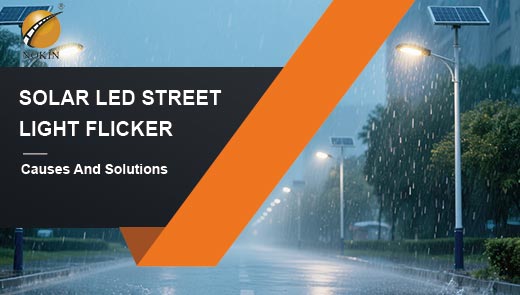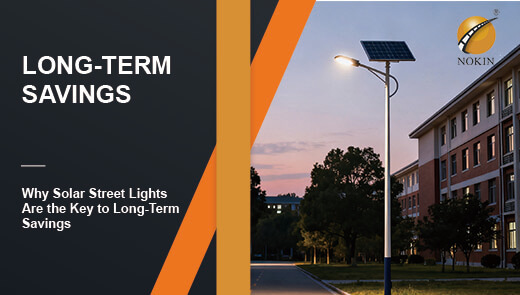What Materials Are Used in Solar Street Light Poles?
Solar street light pole material selection directly affects load bearing, corrosion resistance, installation and cost. Steel, aluminum, fiberglass, concrete have their own advantages and disadvantages, need to be combined with the parameters of the pole, installation challenges and cost balance, comprehensive environment, function and other factors to select the appropriate material.
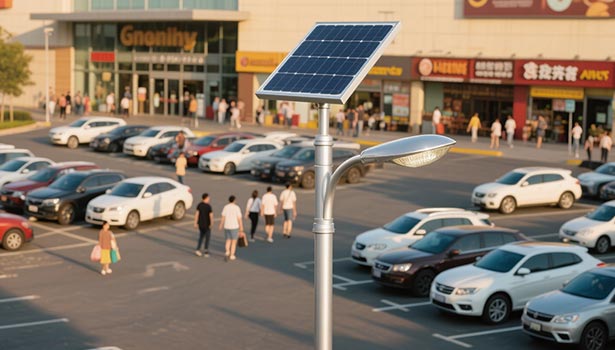
What materials are used for street light poles?
Steel Street Light Poles
Steel street light poles are known for their strength and are ideal for supporting large solar panels or tall street lights. Their strength lies in their ability to handle the weight of large solar panels and the strong wind loads associated with tall poles, making them ideal for arterial streets with high traffic volumes that require bright illumination. However, steel also has obvious shortcomings: greater weight, installation requires heavy machinery to assist, increasing construction costs; and easy to rust, must be treated by hot dip galvanized or cold dip galvanized. Overall, steel street light poles are suitable for storm-prone areas (where galvanization is required to prevent rust), projects with large solar panels, and taller poles (10 meters or more).
Aluminum Street Light Poles
Aluminum is a popular choice for coastal and wet areas due to its “lightweight + corrosion resistant” properties. Its lightweight advantage is significant, the weight is only 1/3 of the same specification steel, the installation does not require heavy equipment, which can significantly reduce the construction cost; at the same time, it has a natural corrosion resistance, the surface oxidation layer can resist salt spray, humid air erosion, without additional rust treatment, suitable for the seaside, lakeside and other scenarios; and it has a beautiful appearance, with smooth lines and a strong sense of modernity, which is suitable for high-grade residential neighborhoods, commercial districts, and other areas that have a requirement for the value of the face. The aluminum is suitable for high-grade residential neighborhoods, commercial areas and other areas that have requirements for face value.
However, the limitations of aluminum should also be noted: the strength is lower than steel, if used for high poles (such as more than 8 meters) or with large solar panels, the need to increase the thickness of the pole. Aluminum street light poles are therefore suitable for use in coastal/wet areas, medium to low level street lights, residential or commercial areas.
Fiberglass Street Light Poles
Fiberglass is not very common, but it offers significant advantages in special environments. It is extremely resistant to corrosion and has no fear of salt spray or chemical corrosion, making it suitable for highly corrosive environments such as those around chemical plants and coastal industrial areas. However, the shortcomings of fiberglass limit its popularity: limited mechanical strength, unable to support large solar panels or high pole design; brittle material, easy to break if collision during transportation and installation, need to be extra careful. Therefore, fiberglass street light poles are suitable for industrial plants, coastal areas with high salt spray, and low load scenarios.
Concrete Street Light Poles
Concrete is the “heavyweight” choice for ultimate durability. It has top wind and weather resistance, withstanding extreme weather (e.g., strong typhoons, dust storms) with little or no damage from environmental erosion; and it has an extremely long service life, with more than 30 years of properly maintained use, making it suitable for remote areas. But the shortcomings of concrete are also very obvious: great weight, installation requires special lifting equipment, construction difficulties and high costs; poor flexibility, once fixed can not adjust the position, if the later need to remodel will be very troublesome. Therefore, concrete street light poles are suitable for remote villages, deserts and other areas where maintenance is inconvenient, or for projects where “lifetime durability” is a mandatory requirement.
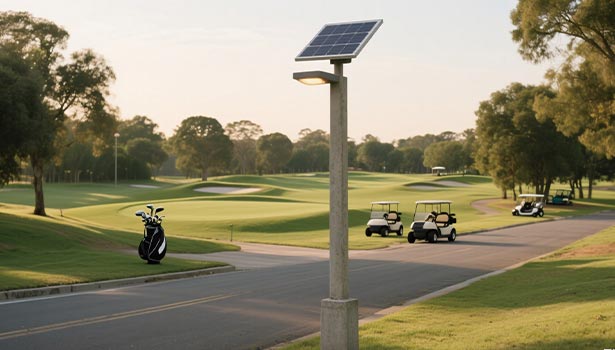
Key Parameters for Material Selection
Pole Height
The solar panel itself will increase the wind resistance, and the higher the height, the more wind load the pole will bear, and the higher the requirement for material strength. If you choose a high pole (10 meters and above), give priority to steel; if you choose aluminum, you need to increase the thickness (usually 0.5-1mm thicker than the conventional specification), otherwise it may shake. For large solar panels (area ≥1.5m2), even for 6-8m medium-height poles, it is recommended to use steel or thickened aluminum - there was a project where a 10m pole was made of standard-thickness aluminum, and after installing a large panel, the pole swayed severely on windy days, and could only be replaced with thick-walled steel.
Thickness and Material
Thickness is the core indicator of resistance to bending and fracture, and must be combined with material properties. The thickness of steel can be flexibly adjusted according to the height and weight of the panel (e.g., for 10-meter pole with large panel, thickness ≥ 4mm is recommended). Thick steel has obvious advantages in load-bearing and wind resistance despite its high cost. Aluminum itself is less strong than steel, if used for high poles or with large panels, the thickness needs to be increased by 1-2mm compared to the same specification of steel (such as the conventional 8-meter aluminum pole thickness of 3mm, with large panels need to be increased to more than 4mm). The situation is different for fiberglass and concrete: the thickness of fiberglass is limited by its mechanical strength (too thick and brittle) and is only suitable for small panels, while concrete enhances stability through its overall weight and does not require any additional thickness adjustments, but it is necessary to ensure uniformity of the pour.
Upper and Lower Diameters
The taper of the bars is determined by the upper and lower diameters and is directly related to wind resistance and fitment. The wider the lower diameter, the better the stability. For example, it is recommended that the bottom diameter of a 10 meter pole should be ≥15cm, and can be increased to 18cm with larger panels to reduce the risk of tilting in high winds. The upper diameter needs to be wide enough to accommodate solar panel brackets or light fixture interfaces. There have been projects where standard panel brackets could not be installed due to the narrow diameter at the top (only 8cm), so additional adapters had to be added, which increased the cost and complexity of construction.
Flange Size and Hole Spacing
Flange is the “bridge” that connects the pole to the foundation, and the wrong size and hole position will directly lead to installation failure. Flange size needs to match the height of the pole (e.g. flange diameter of a 10 meter pole should not be less than 30cm), if it is too small, it will weaken the stability of the whole system - there was a community project that used a 20cm flange to match an 8 meter pole, which was slightly tilted after a rainstorm and had to be reworked for reinforcement.
What Installation Challenges Do Different Pole Materials Present?
Steel Poles
The main installation challenges for steel poles come from weight and rust prevention. Due to the high density of steel, especially for high poles over 10 meters, the weight of a single pole can be hundreds of kilograms, and must rely on heavy equipment such as cranes or forklifts for handling and lifting. If the installation site is narrow, the space for equipment entry and operation will be restricted, and it may be necessary to adjust the station several times to complete the positioning.
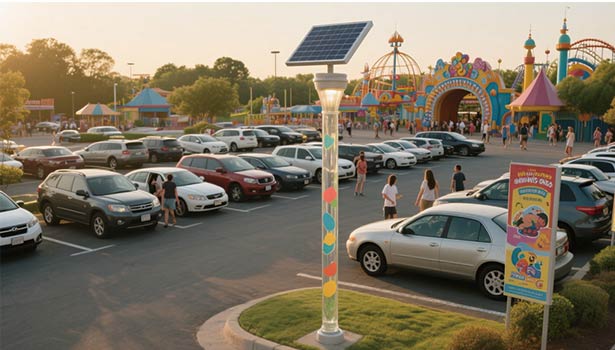
In addition, steel is prone to rust, even for galvanized treated poles, if the galvanized layer breaks during installation due to bumping, the exposed steel surface will rust quickly in a humid environment, so it is necessary to prepare zinc sprays or antirust paints ahead of time to repair the breakage in a timely manner. In the event of a rainy day installation, temporary rust stains may appear on the unprotected surface of the pole, requiring additional sanding and cleaning, adding to the workload.
Aluminum Poles
The difficulty of installing aluminum poles focuses on load-bearing balance and corrosion protection. Although aluminum is lightweight and can be handled manually with small lifting tools, it has low toughness and is prone to bending and deformation if too much force is applied to a single point during installation (e.g., lifting by strangling the same position with a rope), so it is necessary to use a special curved sling to disperse the force evenly.
Another key issue is “galvanic coupling corrosion” - when aluminum rods are in direct contact with steel connectors (e.g., bolts, brackets), the two metals will react chemically in a humid environment, accelerating corrosion. This requires that insulating gaskets (such as rubber or plastic pads) be added to the contact surfaces during installation, and that the condition of the connectors be checked regularly, or else the potential for loosening may occur. In addition, the top interface of aluminum poles is delicate, and improper force when installing solar panel mounts may result in deformation of the interface, affecting the subsequent fixing of the equipment.
Fiberglass Poles
The core installation risk of fiberglass poles is brittle fragility. Although lightweight, this material has poor impact resistance and is prone to surface cracks when struck by hard objects during transportation and installation - cracks that may not be visible at first, but can grow in size and eventually break when subjected to wind and weight over a long period of time.
Therefore, it is necessary to avoid direct friction between the pole and the ground or other objects when installing, and it is better to wrap the collision-prone parts with foam or cotton cloth. In addition, the cutting or drilling of fiberglass poles generates fine fiber dust, which not only pollutes the environment, but can also irritate the skin and respiratory tract, so the installer needs to wear protective masks, gloves and goggles, and clean up the site in a timely manner after the operation.
Concrete Poles
The installation of concrete poles revolves almost entirely around weight and positioning accuracy. A single 8-meter concrete pole can weigh 1-2 tons and must be lifted by a large crane, and the ground at the installation site is extremely load-bearing - if the soil around the foundations is soft, the crane can get stuck and needs to be reinforced with steel plates in advance.
More critical is the positioning problem: once the concrete pole is fixed, it is not possible to fine-tune the angle like a metal pole, if the installation deviates from the preset position by even 5cm, it will lead to the solar panel orientation deviation or the lighting range of the lamps and lanterns are misplaced. In addition, if there are air bubbles or cracks in the concrete poles when they are poured, uneven forces during installation may cause breakage, so the integrity of the poles needs to be carefully checked before installation.
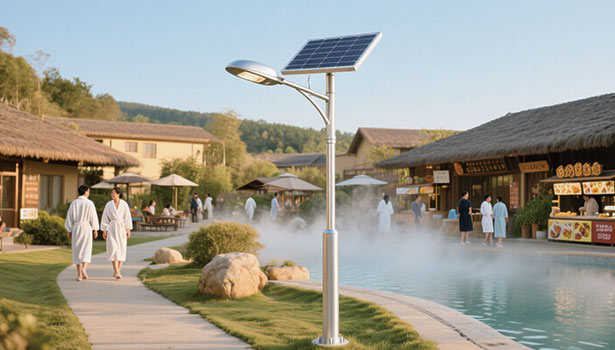
How do Different Pole Materials Affect Costs?
Steel Street Light Poles
The raw steel material price is stable, but you need to pay extra for galvanized treatment. Installation costs are higher, requiring crane rental and more workers due to its weight, and about 1.5 times that of aluminum poles. However, it has a lower long-term cost. Galvanized steel poles can last up to 15-20 years, during which time they only need to be inspected periodically (1-2 times per year), with almost no additional maintenance expenses. On balance, steel poles are suitable for long-term projects (10+ years), especially in rainy or windy areas - a high up-front investment, but durable enough to avoid the hidden costs of frequent replacement.
Aluminum Street Light Poles
Aluminum poles have a high upfront cost, with the raw material price of aluminum higher than steel, but they save on galvanizing costs by not requiring additional rust prevention treatments. Installation costs are low. The lightweight nature of aluminum poles eliminates the need for large equipment, and installation can be done manually with small lifting tools at 60-70% of the cost of steel poles.
Long-term costs are moderate. Aluminum poles have a 10-15 year lifespan and require regular inspections of connections to prevent corrosion and loosening, resulting in slightly higher maintenance costs than steel poles, but lower than ungalvanized steel. For medium-term projects (5-10 years), especially in coastal areas (where salt spray tends to corrode steel), aluminum poles offer a significant total cost advantage - both in terms of reduced installation expenditures and the later hassle of rust prevention and maintenance.
Fiberglass Street Light Poles
Fiberglass poles have a higher up-front cost, with the material itself and the complexity of the machining process, making them the highest initial investment of the four. Installation costs are low, the weight is close to that of aluminum poles, and can be handled and installed manually, without heavy equipment, at a cost comparable to aluminum poles. Low long-term cost, excellent corrosion resistance, almost no maintenance, life expectancy of 8-12 years, but its brittleness determines that once damaged (e.g., collision, strong wind breakage) it must be replaced as a whole, can not be repaired, and the cost of replacement is high. Therefore, fiberglass poles are only recommended for highly corrosive environments and are far less cost-effective than steel and aluminum for other scenarios.
Concrete Street Light Poles
Concrete poles have extremely high upfront costs, not only for materials, but also for transportation and custom pouring. Installation costs are also extremely high, with large single weights, the need to rent large cranes, and the need to reinforce foundations (to prevent settlement) prior to installation, making installation costs more than twice that of steel poles.
However, its long-term cost is extremely low, life expectancy of up to 20-30 years, wind and corrosion resistance, almost no maintenance. However, concrete poles are extremely inflexible - if they need to be relocated or adjusted in height at a later stage, they can almost always be dismantled and rebuilt, with high hidden costs. Therefore, it is only suitable for remote areas (e.g. deserts, villages) or projects with rigid requirements for “lifetime durability”, and is not recommended for common scenarios.
The choice of materials for solar street light poles needs to take into account the environmental suitability, functional requirements, installation difficulty and cost-effectiveness and other points. Only in order to protect the stable operation of street lights at the same time, to achieve the optimal cost of the whole life cycle.


